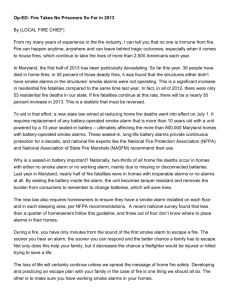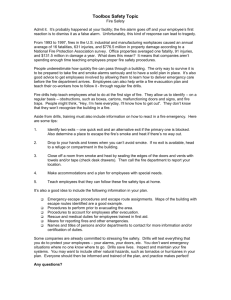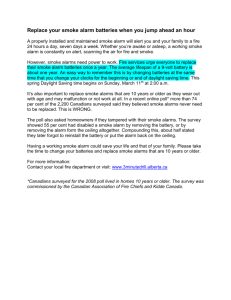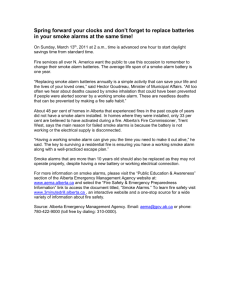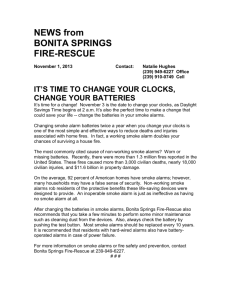Lesson Plan
advertisement
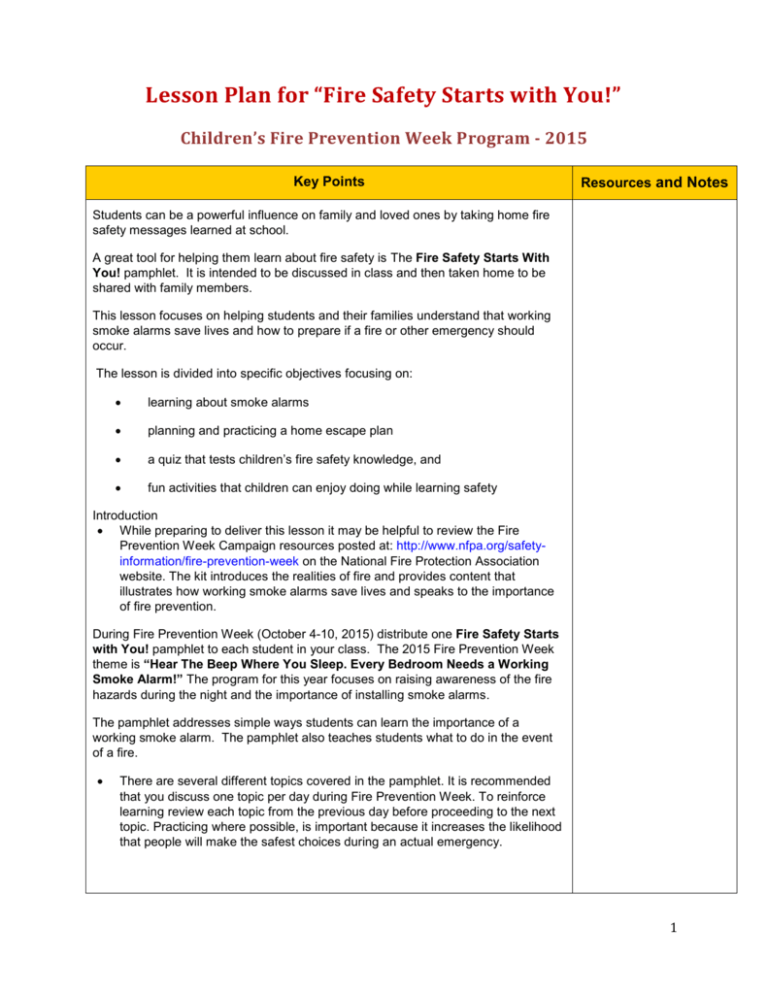
Lesson Plan for “Fire Safety Starts with You!” Children’s Fire Prevention Week Program - 2015 Key Points Resources and Notes Students can be a powerful influence on family and loved ones by taking home fire safety messages learned at school. A great tool for helping them learn about fire safety is The Fire Safety Starts With You! pamphlet. It is intended to be discussed in class and then taken home to be shared with family members. This lesson focuses on helping students and their families understand that working smoke alarms save lives and how to prepare if a fire or other emergency should occur. The lesson is divided into specific objectives focusing on: learning about smoke alarms planning and practicing a home escape plan a quiz that tests children’s fire safety knowledge, and fun activities that children can enjoy doing while learning safety Introduction While preparing to deliver this lesson it may be helpful to review the Fire Prevention Week Campaign resources posted at: http://www.nfpa.org/safetyinformation/fire-prevention-week on the National Fire Protection Association website. The kit introduces the realities of fire and provides content that illustrates how working smoke alarms save lives and speaks to the importance of fire prevention. During Fire Prevention Week (October 4-10, 2015) distribute one Fire Safety Starts with You! pamphlet to each student in your class. The 2015 Fire Prevention Week theme is “Hear The Beep Where You Sleep. Every Bedroom Needs a Working Smoke Alarm!” The program for this year focuses on raising awareness of the fire hazards during the night and the importance of installing smoke alarms. The pamphlet addresses simple ways students can learn the importance of a working smoke alarm. The pamphlet also teaches students what to do in the event of a fire. There are several different topics covered in the pamphlet. It is recommended that you discuss one topic per day during Fire Prevention Week. To reinforce learning review each topic from the previous day before proceeding to the next topic. Practicing where possible, is important because it increases the likelihood that people will make the safest choices during an actual emergency. 1 Lesson Plan for “Fire Safety Starts with You!” Children’s Fire Prevention Week Program - 2015 Discuss the meaning of the word “prevention.” Introduce the idea that many home fires can be prevented and that students have the power to help make their home a safer place. Introduce the topics covered in the Fire Safety Starts with You! pamphlet: learning about smoke alarms , planning and practicing a home escape plan, sharing the knowledge gained with family members, assessing family/household safety through a quiz and demonstrating fire safe behaviors. Use the Fire Safety Starts with You! pamphlet as a guide. Ask students if anyone can identify a smoke alarm and if they know where they are in their homes. Ask them if they have a smoke alarm in their bedroom or outside their bedroom door. Continue by asking them if they know what to do if they hear the smoke alarm. Working smoke alarms save lives. That’s right, having smoke alarms in your home is very important. Smoke alarms let you know there is a fire. Working smoke alarms also give you time to get outside and stay outside if there is a fire. Encourage students to take the pamphlet home and to discuss the pamphlet with their parent/guardian or other grown-ups. Ask them to find the smoke alarms with their parent or guardian and discuss how each working smoke alarm can save their lives. REMINDER FOR CLASSROOM TEACHERS ONLY: Please collect all the entries from children in your classroom and mail them to Office of the Fire Commissioner, 16th Floor, Commerce Place, 10155-102 Street, Edmonton, AB. T5J 4L4 or scan and email to firecomm@gov.ab.ca on or before the draw date of November 2, 2015 sure to enter your name our draw for some super prizes. Thank you for your participation! Key Points Resources and Notes 2 Lesson Plan for “Fire Safety Starts with You!” Children’s Fire Prevention Week Program - 2015 Objective #1 – Learning about smoke alarms 1. Children should be taught to identify the sound of a working smoke alarm. Press the test button on a smoke alarm as a demonstration. Warn them first. 2. What is your smoke alarm telling you if it “chirps? That means the battery is low and a new battery needs to be installed. Demonstrate the sound with a low battery and then show how the battery is changed (which is something a parent or adult would do) and then test the alarm to show that it is working. Testing the battery is something that we do “Once a Month”! 3. Ask students if they know anyone who has experienced a home fire and where or how the fire started. Emphasize that in addition to cooking, electrical, heating appliances and smoking materials are also major causes of home fires. 4. Ask students to complete the Smoke Alarm Safety Word Search activity in the Fire Safety Starts with You! activity pamphlet. Did everyone find the 12 words? 5. Explain that this activity was developed to have them think about words regarding smoke alarm and fire safety. 6. Discuss the importance of having working smoke alarms and telling a responsible adult that: - Once a month – test your smoke alarms using the test button. If the smoke alarm doesn’t make a sound replace the battery. If it still doesn’t work replace the smoke alarm. - Change the battery in your smoke alarm according to manufacturer’s instructions or when you hear the low battery alarm. - Replace the smoke alarm with a new one every ten years. Have a smoke alarm to demonstrate the sounds Visit: http://www.nfpa.org/safetyinformation/fire-preventionweek/for-teachers Sing and dance along with SteveSongs as Rosealie and her little brother learn about smoke alarms Pamphlet Smoke Alarm Safety Word Search 3 Lesson Plan for “Fire Safety Starts with You!” Children’s Fire Prevention Week Program - 2015 Key Points Resources and Notes Objective #2 – Home Fire Escape Planning 1. Ask students what they would do if they heard the fire alarm at school. Ask how their exit plan would be different at home. Explain that a fire escape plan is a way to prepare in case of a fire. Explain the importance of creating a home fire escape plan. Pamphlet - Home Fire Escape Plan 2. Emphasize that all family members must know how to respond to a fire emergency by regularly practicing a home fire escape plan. Home fire escape plans should show two ways out of every room and that windows and locks must open easily. Once outside all family members should gather and stay at the Family Meeting Place! 3. Ask students to complete the Home Fire Escape Plan in the Fire Safety Starts with You! pamphlet. 4. Emphasize that practice is the key when it comes to escape plans. It is not enough just to have a fire escape plan – to escape safely from a home fire you’ve got to make sure that everyone has also practiced the plan. 5. Ask students what could be a suitable meeting place. Note: Fires grow fast and are hot and deadly. A fire in a modern home can become life threatening in as little as three minutes. Toxic gases from a fire can reach temperatures in excess of 700C or more and scorch the lungs in one breath. In addition, smoke from fires can be dark and obscure visibility, irritate the eyes and breathing passages and can cause confusion due to lower levels of oxygen. People have become disoriented in fires in their own homes. In a fire seconds count. Escaping a fire must happen very quickly — within a few minutes. Fires can grow very rapidly and there may be only a few minutes (three minutes or less according to the latest research) before conditions become fatal in a house fire. Practicing an escape plan ahead of time makes the actual response quicker and a more appropriate reaction. Objective #3 Home Safety Checklist Pamphlet – Home Safety Checklist 1. Ask students to review the checklist in their home with their parent/guardian or other grown-ups. 2. Have students bring the completed checklist back to school for discussion. 4 Lesson Plan for “Fire Safety Starts with You!” Children’s Fire Prevention Week Program - 2015 Key Points Resources and Notes Extension Activities 1. Make book marks for their books. A bookmark template is available at: http://www.sparky.org/downloads/Bookmarks.pdf . 2. Invite a fire fighter into the classroom to review completed pamphlets and give tips on being burn and fire safe. 3. Have a safety poster contest and judge the students’ illustrations. Be sure to recognize each child’s effort! 4. Have students bring in newspaper articles or TV news stories about house fires. Discuss details and talk about how the fire may have been prevented. 5. Practice the school escape plan. Use the signs or a sheet to indicate smoke. Students will practice using a second way out or getting low and going under the smoke to their exit. 6. Have younger children fold an origami dog. Instructions are available on the NFPA website. http://www.sparky.org/downloads/origamidog.pdf 7. Direct students to http://www.sparky.org/ where they can find out more information about fire safety and play interactive games with Sparky. Conclusion Review the “Fire Safety Starts With You” pamphlet and ask students if they changed any answers and why. “Fire Safety Starts with You” pamphlet Emphasize that “Hear The Beep Where You Sleep. Summarize the lessons by making a list of safety tips for kids and review the three behaviors necessary to ensure smoke alarms can serve as life-saving devices. - Once a month – test your smoke alarms using the test button. If the smoke alarm doesn’t make a sound replace the battery. If it still doesn’t work replace the smoke alarm. - Change the battery in your smoke alarm according to manufacturer’s instructions or when you hear the low battery alarm. - Replace the smoke alarm with a new one every ten years. Now it’s time to include the parents/guardians! Ask students to take their activity pamphlet home to complete with their parents/guardians so they can learn to be fire safe too! 5

